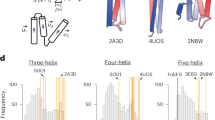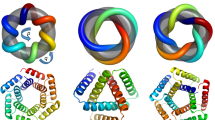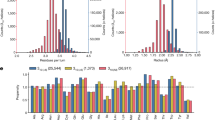Abstract
Despite efforts for over 25 years, de novo protein design has not succeeded in achieving the TIM-barrel fold. Here we describe the computational design of four-fold symmetrical (β/α)8 barrels guided by geometrical and chemical principles. Experimental characterization of 33 designs revealed the importance of side chain–backbone hydrogen bonds for defining the strand register between repeat units. The X-ray crystal structure of a designed thermostable 184-residue protein is nearly identical to that of the designed TIM-barrel model. PSI-BLAST searches do not identify sequence similarities to known TIM-barrel proteins, and sensitive profile-profile searches indicate that the design sequence is distant from other naturally occurring TIM-barrel superfamilies, suggesting that Nature has sampled only a subset of the sequence space available to the TIM-barrel fold. The ability to design TIM barrels de novo opens new possibilities for custom-made enzymes.
This is a preview of subscription content, access via your institution
Access options
Subscribe to this journal
Receive 12 print issues and online access
$259.00 per year
only $21.58 per issue
Buy this article
- Purchase on Springer Link
- Instant access to full article PDF
Prices may be subject to local taxes which are calculated during checkout





Similar content being viewed by others
References
Kuhlman, B. et al. Design of a novel globular protein fold with atomic-level accuracy. Science 302, 1364–1368 (2003).
Huang, P.-S. et al. High thermodynamic stability of parametrically designed helical bundles. Science 346, 481–485 (2014).
Joh, N.H. et al. De novo design of a transmembrane Zn2+-transporting four-helix bundle. Science 346, 1520–1524 (2014).
Koga, N. et al. Principles for designing ideal protein structures. Nature 491, 222–227 (2012).
Smadbeck, J. et al. De novo design and experimental characterization of ultrashort self-associating peptides. PLOS Comput. Biol. 10, e1003718 (2014).
Bellows-Peterson, M.L. et al. De novo peptide design with C3a receptor agonist and antagonist activities: theoretical predictions and experimental validation. J. Med. Chem. 55, 4159–4168 (2012).
Khoury, G.A., Smadbeck, J., Kieslich, C.A. & Floudas, C.A. Protein folding and de novo protein design for biotechnological applications. Trends Biotechnol. 32, 99–109 (2014).
Correia, B.E. et al. Proof of principle for epitope-focused vaccine design. Nature 507, 201–206 (2014).
Sterner, R. & Höcker, B. Catalytic versatility, stability, and evolution of the (βα)8-barrel enzyme fold. Chem. Rev. 105, 4038–4055 (2005).
Gerlt, J.A. New wine from old barrels. Nat. Struct. Biol. 7, 171–173 (2000).
Höcker, B. Directed evolution of (βα)8-barrel enzymes. Biomol. Eng. 22, 31–38 (2005).
Kiss, G., Çelebi Ölçüm, N., Moretti, R., Baker, D. & Houk, K.N. Computational enzyme design. Angew. Chem. Int. Ed. Engl. 52, 5700–5725 (2013).
Höcker, B., Claren, J. & Sterner, R. Mimicking enzyme evolution by generating new (βα)8-barrels from (βα)4-half-barrels. Proc. Natl. Acad. Sci. USA 101, 16448–16453 (2004).
Höcker, B., Lochner, A., Seitz, T., Claren, J. & Sterner, R. High-resolution crystal structure of an artificial (βα)8-barrel protein designed from identical half-barrels. Biochemistry 48, 1145–1147 (2009).
Claren, J., Malisi, C., Höcker, B. & Sterner, R. Establishing wild-type levels of catalytic activity on natural and artificial (βα)8-barrel protein scaffolds. Proc. Natl. Acad. Sci. USA 106, 3704–3709 (2009).
Fortenberry, C. et al. Exploring symmetry as an avenue to the computational design of large protein domains. J. Am. Chem. Soc. 133, 18026–18029 (2011).
Goraj, K., Renard, A. & Martial, J.A. Synthesis, purification and initial structural characterization of octarellin, a de novo polypeptide modelled on the α/β-barrel Proteins. Protein Eng. 3, 259–266 (1990).
Houbrechts, A. et al. Second-generation octarellins: two new de novo (β/α)8 polypeptides designed for investigating the influence of β-residue packing on the α/β-barrel structure stability. Protein Eng. 8, 249–259 (1995).
Tanaka, T. et al. Characteristics of a de novo designed protein. Protein Sci. 3, 419–427 (1994).
Offredi, F. et al. De novo backbone and sequence design of an idealized α/β-barrel protein: evidence of stable tertiary structure. J. Mol. Biol. 325, 163–174 (2003).
Figueroa, M. et al. Octarellin VI: using Rosetta to design a putative artificial (β/α)8 protein. PLoS ONE 8, e71858 (2013).
Nagarajan, D., Deka, G. & Rao, M. Design of symmetric TIM barrel proteins from first principles. BMC Biochem. 16, 18 (2015).
Murzin, A.G., Lesk, A.M. & Chothia, C. Principles determining the structure of β-sheet barrels in proteins I. A theoretical analysis. J. Mol. Biol. 236, 1369–1381 (1994).
Ochoa-Leyva, A. et al. Exploring the structure-function loop adaptability of a (β/α)8-barrel enzyme through loop swapping and hinge variability. J. Mol. Biol. 411, 143–157 (2011).
Ochoa-Leyva, A. et al. Protein design through systematic catalytic loop exchange in the (β/α)8 fold. J. Mol. Biol. 387, 949–964 (2009).
Huang, P.-S. et al. RosettaRemodel: a generalized framework for flexible backbone protein design. PLoS ONE 6, e24109 (2011).
Parmeggiani, F. et al. A general computational approach for repeat protein design. J. Mol. Biol. 427, 563–575 (2015).
Yang, X., Kathuria, S.V., Vadrevu, R. & Matthews, C.R. βα-hairpin clamps brace βαβ modules and can make substantive contributions to the stability of TIM barrel proteins. PLoS ONE 4, e7179 (2009).
Höcker, B., Beismann-Driemeyer, S., Hettwer, S., Lustig, A. & Sterner, R. Dissection of a (βα)8-barrel enzyme into two folded halves. Nat. Struct. Biol. 8, 32–36 (2001).
Romero-Romero, S., Costas, M., Rodríguez-Romero, A. & Fernández-Velasco, D.A. Reversibility and two state behaviour in the thermal unfolding of oligomeric TIM barrel proteins. Phys. Chem. Chem. Phys. 17, 20699–20714 (2015).
Zhang, Y. & Skolnick, J. TM-align: a protein structure alignment algorithm based on the TM-score. Nucleic Acids Res. 33, 2302–2309 (2005).
Minami, S., Sawada, K. & Chikenji, G. MICAN: a protein structure alignment algorithm that can handle multiple-chains, inverse alignments, C(α) only models, alternative alignments, and non-sequential alignments. BMC Bioinformatics 14, 24 (2013).
Altschul, S.F. et al. Gapped BLAST and PSI-BLAST: a new generation of protein database search programs. Nucleic Acids Res. 25, 3389–3402 (1997).
Söding, J. Protein homology detection by HMM-HMM comparison. Bioinformatics 21, 951–960 (2005).
Remmert, M., Biegert, A., Hauser, A. & Söding, J. HHblits: lightning-fast iterative protein sequence searching by HMM-HMM alignment. Nat. Methods 9, 173–175 (2012).
Farías-Rico, J.A., Schmidt, S. & Höcker, B. Evolutionary relationship of two ancient protein superfolds. Nat. Chem. Biol. 10, 710–715 (2014).
Alva, V., Remmert, M., Biegert, A., Lupas, A.N. & Söding, J. A galaxy of folds. Protein Sci. 19, 124–130 (2010).
Rämisch, S., Weininger, U., Martinsson, J., Akke, M. & Andre, I. Computational design of a leucine-rich repeat protein with a predefined geometry. Proc. Natl. Acad. Sci. USA 111, 17875–17880 (2014).
Giger, L. et al. Evolution of a designed retro-aldolase leads to complete active site remodeling. Nat. Chem. Biol. 9, 494–498 (2013).
Kabsch, W. & Sander, C. Dictionary of protein secondary structure—pattern-recognition of hydrogen-bonded and geometrical features. Biopolymers 22, 2577–2637 (1983).
Kabsch, W. XDS. Acta Crystallogr. D Biol. Crystallogr 66, 125–132 (2010).
Emsley, P. & Cowtan, K. Coot: model-building tools for molecular graphics.Acta Crystallogr. D Biol. Crystallogr. 60, 2126–2132 (2004).
DiMaio, F. et al. Improved low-resolution crystallographic refinement with Phenix and Rosetta. Nat. Methods 10, 1102–1104 (2013).
Song, Y. et al. High-resolution comparative modeling with RosettaCM. Structure 21, 1735–1742 (2013).
Afonine, P.V. et al. Towards automated crystallographic structure refinement with phenix.refine. Acta Crystallogr. D Biol. Crystallogr. 68, 352–367 (2012).
Frickey, T. & Lupas, A. CLANS: a Java application for visualizing protein families based on pairwise similarity. Bioinformatics 20, 3702–3704 (2004).
Acknowledgements
We thank R. Krishnamurty and C. Tinberg for comments on the manuscript, as well as S. Ovchinnikov, A.C. Stiel and S. Schmidt for technical advice. D.A.F.V. thanks the Dirección General de Asuntos del Personal Académico UNAM for a sabbatical stay fellowship, and K.F. acknowledges a fellowship from the International Max Planck Research School (IMPRS) “From Molecules to Organisms” Tübingen. F.P. was supported by Human Frontier Science Program Long-term fellowship LT000070/2009-l. This work was facilitated through the use of advanced computational storage and networking infrastructure provided by the Hyak supercomputer system at the University of Washington. This research was also done using resources provided by the Open Science Grid (OSG), which is supported by the US National Science Foundation and the US Department of Energy's Office of Science. We would like to particularly thank M. Rynge and J. McGee of the OSG Engagement Team at the Renaissance Computing Institute (RENCI) and M. Livny and the HTCondor Team of the University of Wisconsin–Madison for their technical and logistical guidance in our use of OSG resources. This work was supported by grants from the Defense Threat Reduction Agency (DTRA) and the Howard Hughes Medical Institute to D.B., Deutsche Forschungsgemeinschaft grant HO4022/1-2 and Max Planck funds to B.H., and grants CONACYT 99857 and PAPIIT-UNAM IN219913 to D.A.F.V.
Author information
Authors and Affiliations
Contributions
P.-S.H., K.F., D.A.F.V., B.H. and D.B. designed the research. P.-S.H. wrote program code and designed structures with help from B.H. and D.A.F.V. P.-S.H., F.P. and D.A.F.V. built the clones. K.F. and B.H. solved the crystal structure of sTIM-11 and collected thermodynamic data for sTIMs. F.P. characterized the first designs. P.-S.H., K.F., B.H. and D.B. collected and analyzed sequence and structure comparison data. K.F. and B.H. generated the cluster map. P.-S.H., K.F., B.H. and D.B. wrote the manuscript with help from all the authors. All authors discussed the results and commented on the manuscript.
Corresponding authors
Ethics declarations
Competing interests
The authors declare no competing financial interests.
Supplementary information
Supplementary Text and Figures
Supplementary Results, Supplementary Figures 1–9 and Supplementary Tables 1–5. (PDF 6188 kb)
Rights and permissions
About this article
Cite this article
Huang, PS., Feldmeier, K., Parmeggiani, F. et al. De novo design of a four-fold symmetric TIM-barrel protein with atomic-level accuracy. Nat Chem Biol 12, 29–34 (2016). https://doi.org/10.1038/nchembio.1966
Received:
Accepted:
Published:
Issue Date:
DOI: https://doi.org/10.1038/nchembio.1966
This article is cited by
-
Design of complicated all-α protein structures
Nature Structural & Molecular Biology (2024)
-
Dynamics of loops surrounding the active site architecture in GH5_2 subfamily TfCel5A for cellulose degradation
Biotechnology for Biofuels and Bioproducts (2023)
-
ProRefiner: an entropy-based refining strategy for inverse protein folding with global graph attention
Nature Communications (2023)
-
Controllable protein design with language models
Nature Machine Intelligence (2022)
-
Protein sequence design with a learned potential
Nature Communications (2022)



